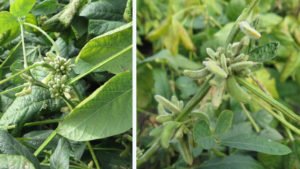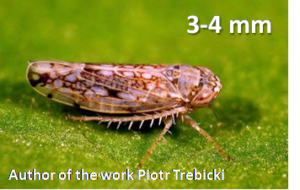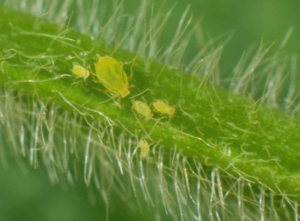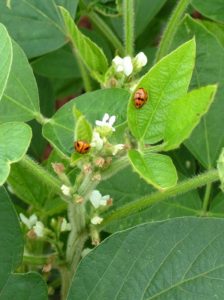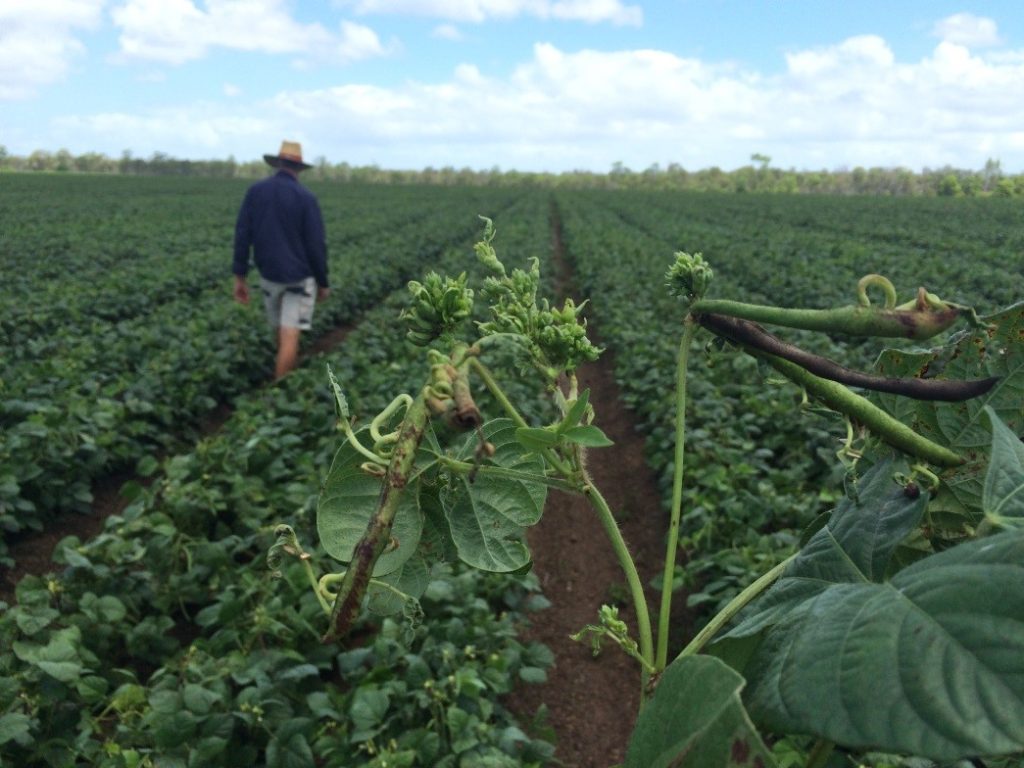A devastating disease was observed in several paddocks of soybean crops in the Branchview area of the Darling Downs in late autumn 2016. Almost 100 percent of plants were affected in some paddocks. The affected plants produced no, or very few filled pods and instead had a proliferation of tiny immature pods as shown in Photos 1 and 2. The plants also remained green while nearby, unaffected crops matured and browned off as normally expected.
The severely affected crops had so few filled pods that they were uneconomical to harvest. Darling Downs agronomist, Matthew Holding, reported that yield losses were very high across two farms. With symptoms only becoming severe late in the crop cycle, the majority of the crop input costs, such as irrigation and weed control had already been committed to the crops before the damage was apparent, resulting in significant economic losses. Mr Holding alerted Queensland Department of Agriculture and Fisheries, and University of Southern Queensland plant pathologists and entomologists to the issue in May but no link was found with insect damage, viral or fungal diseases. However, about 70 percent of the affected plants tested positive for the presence of a phytoplasma using lab based molecular diagnostics. Phytoplasmas are specialised bacteria that survive within plants and the sap-sucking insects that vector them, leafhoppers and planthoppers. These sap-sucking insects are the only insects that can transmit phytoplasmas and they may pick up the pathogen from nearby weed hosts before moving it into crops. There is a wide range of phytoplasmas and they cause a variety of symptoms in different hosts but legume crops often display little leaf symptoms and sterility of flowers.
The observed pod symptoms from the Darling Downs were similar to typical phytoplasma symptoms but the lack of little leaf symptoms was unexpected and the extent of damage across entire paddocks has not been observed before. While we have not yet been able to demonstrate the detected pathogen can cause the observed symptoms under controlled conditions, we believe that the phytoplasma was the cause of the disease outbreaks on the Darling Downs. The lab test results indicate the phytoplasma is closely related to pigeon pea little leaf phytoplasma, which has been previously detected in Australia in pigeon pea and stylosanthes.
The extent of damage caused by this outbreak was not typical and we urge growers and agronomist to be on the lookout for these symptoms in the coming season. It is not certain that the disease will reappear in the coming season, but if it does, we will need to continue investigations including which insect species is responsible for transmission, its host range and possible control options. One potential vector is the brown leaf hopper Orosius orientalis (Photo 3).
While soybean aphids were present in the affected Downs crops, it is extremely unlikely they were responsible because aphids are not phytoplasma vectors, and soybean aphid attack has never been observed to lead to the small bunchy pod symptoms seen on the Downs. However, heavy soybean aphid infestations can also delay crop maturity (Photo 4).
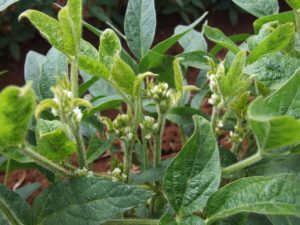
Photo 5: Typical aphid damage symptoms in flowering soybeans showing including distorted new leaves sticky with honey dew. See also white skins shed by moulting aphid nymphs.
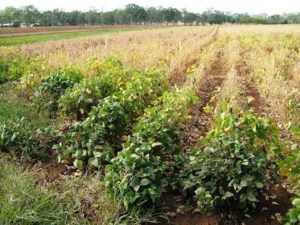
Photo 4: Crop greening due to soybean aphids. Unsprayed soybean plants closest to viewer, show delayed maturity (green plants), contrasting with the harvest-ready main crop which was sprayed for soybean aphids.
Growers and consultants should monitor soybeans for this pest from the early vegetative stages onwards. Action should be taken if populations exceed threshold by flowering, the threshold being 250 aphids per plant. As a rule of thumb, aphids are above threshold if aphids can be seen on the plant’s stem. Also look for distorted new growth leaves with sticky honey dew (Photo 5), small bright green aphids and their cast-off skins shed by moulting nymphs (Photo 6), as well as predatory ladybirds, which are good aphid indicators (Photo 7).
If spraying is warranted, the preferred option is pirimicarb for which a permit renewal is pending (previously PER 13451.) Pirimicarb is the preferred option because it has no impact on key aphid predators including ladybirds and hoverfly larvae.
At about the same time as the phytoplasma disease outbreaks on the Darling Downs, several mungbean crops in the Springsure and Gindi regions of central Queensland had high numbers of plants displaying typical phytoplasma symptoms with little leaves (or sometimes called witches broom) and sterility of flowers (Photo 8). This resulted in significant losses in crops with high incidences of affected plants. It is not clear if it was the same phytoplasma causing the disease outbreaks in central Queensland and on the Darling Downs, but perhaps there were widespread conditions favourable for leafhoppers to pick up the pathogen from weedy hosts and move through the crops in both regions.
A recent detection of Cowpea mild mottle virus in soybean and French bean in South East Queensland has also caused significant concern for bean growers. It caused widespread losses for French bean growers in the Fassifern Valley and alarmingly has also been reported to cause significant losses in soybean crops overseas. This is a new virus to Australia, transmitted by silver leaf whitefly and in the seed of some hosts. It is not clear how long it has been in Australia or if it will cause disease outbreaks in soybean production areas but growers and agronomists are urged to keep a look out for this virus. Symptoms in soybean include distorted leaves with obvious mottle (Photo 9).
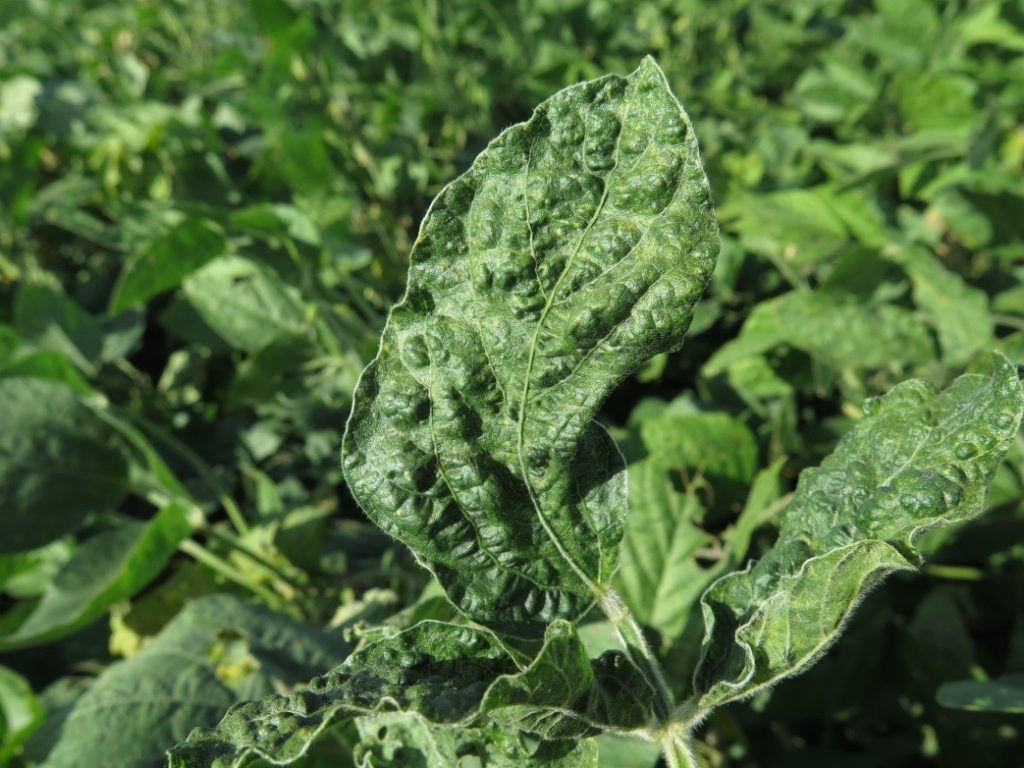
Photo 9. Distorted leaves and mottle symptoms of cowpea mild mottle virus on soybean from Lockyer Valley crop.
If you have seen symptoms of Cowpea mild mottle virus or phytoplasma and you live in Queensland report it to the Biosecurity Queensland on 13 25 23. Images and text may be sent to [email protected]. For all other areas contact the national Exotic Plant Pest hotline on 1800 084 881.
Article contributors: Murray Sharman, Hugh Brier, Fiona Filardo, Sue Thompson, Matthew Holding, Denis Persley

